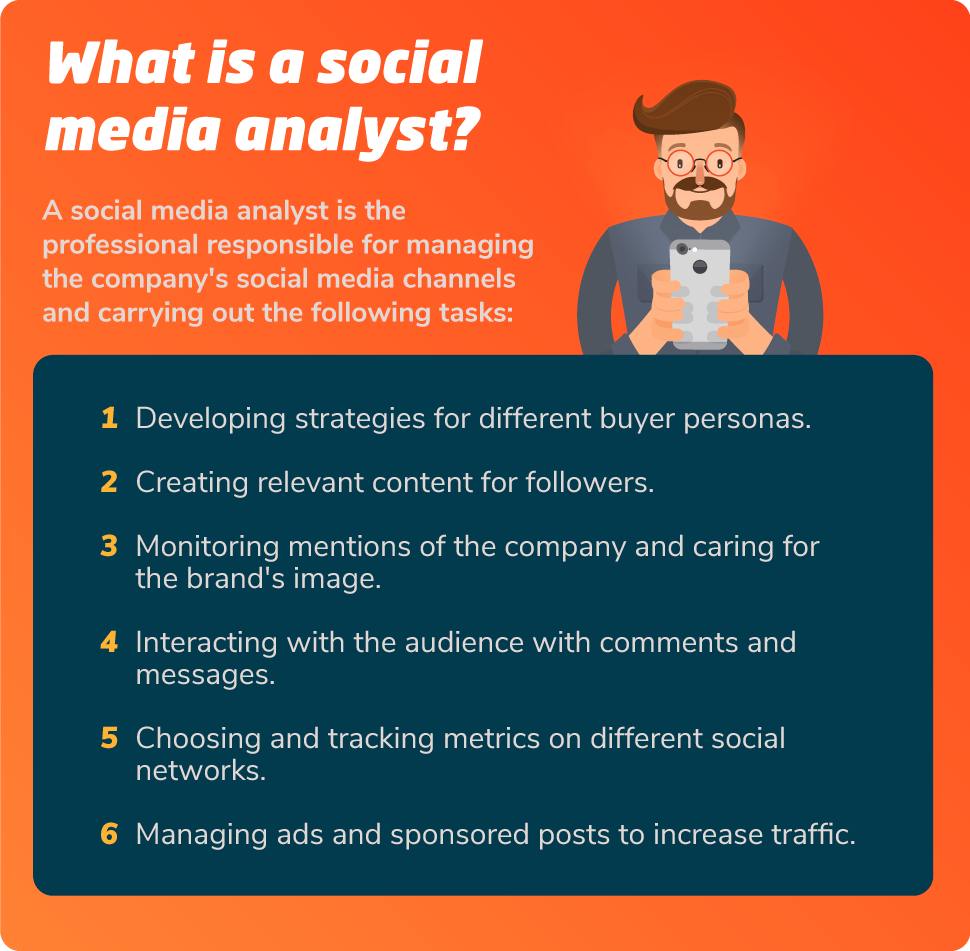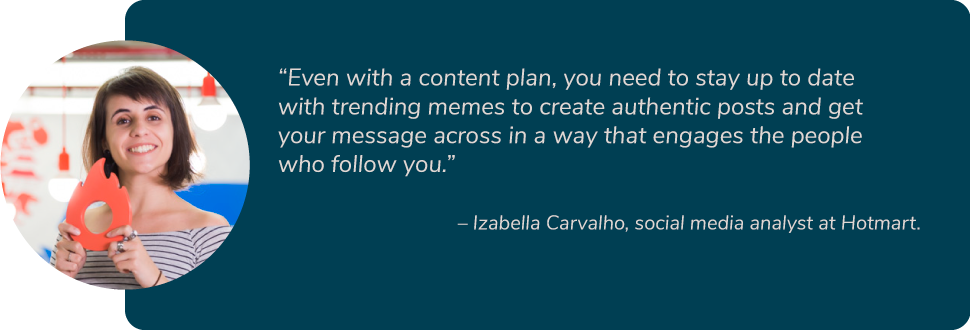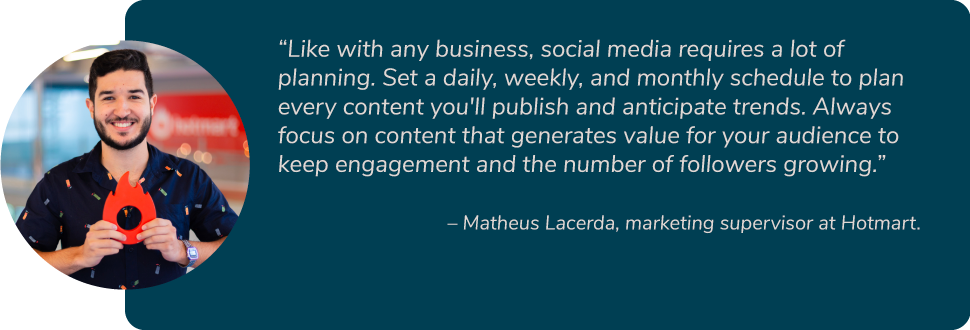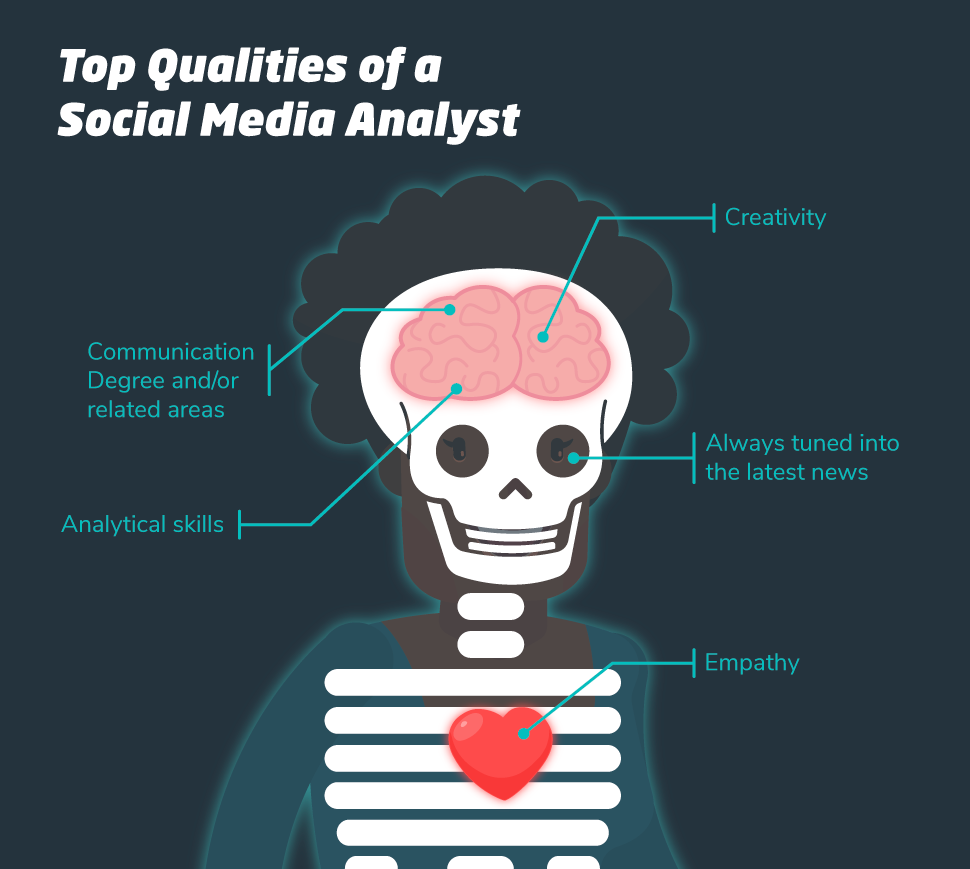
What Makes a Great Social Media Analyst?
Social networking sites have transformed communication – they have brought companies and customers closer together, strengthening interaction and providing an important impact to brand building and maintenance. In this scenario, it’s necessary to have a dedicated professional to understand and monitor this relationship, and this is one of the main duties of a social media […]

What will we see in this post
Social networking sites have transformed communication – they have brought companies and customers closer together, strengthening interaction and providing an important impact to brand building and maintenance.
In this scenario, it’s necessary to have a dedicated professional to understand and monitor this relationship, and this is one of the main duties of a social media analyst.
Nowadays, it’s practically impossible to think of an organization with no communication channels on social media.
Whether it’s a profile on Facebook, Instagram, Twitter, or LinkedIn, brands are present in these environments to monitor what’s being said about them and influence customers’ decision-making.
A social media analyst is a strategic professional in developing mechanisms and tools to bring the business closer to its followers, customers, and potential customers.
In this post, we will talk about the distinct characteristics of a social media professional, showing how this position has become increasingly indispensable for the strengthening and growth of organizations.
Let’s get started!
What is a social media analyst?
Social media has become a veritable showcase for brands. Some people joke that if a business isn’t on one of these channels, it doesn’t exist.
This thinking follows the logic of user growth on social media in recent years.
Therefore, organizations must be present in these environments to establish a closer dialogue with their customers and potential customers, in addition to delivering relevant content.
It’s within this context that social media analysts come in because they are responsible for developing social media strategies, creating content, interacting with the audience, and tracking metrics.
Check out below, the main tasks that a social media analyst performs on a daily basis:

In order to understand why social media analysts have become increasingly important for the digital marketing strategies of organizations, it’s necessary to delve deeper into the work developed by this type of professional.
Producing content for social media is only one of the social media analyst’s duties. In fact, they need a lot of knowledge about the business’ different types of persona, in order to develop a specific and targeted strategy for each one.
This needs to be a personalized and close-up approach, in order to establish an effective dialog.
Social networking allows for unique benefits, such as strengthening empathy.
It’s through one of these channels that brands can interact with dissatisfied users, for example, understanding the point that caused bad feelings and converting this experience into something positive and satisfactory.
You need to remember that a dissatisfied customer on social channels can cause a cascading effect for brands.
On social media profiles, posts gain amplitude, echoing in the mind of several people and changing the impressions some had regarding a certain brand.
A social media analyst, therefore, is the professional who strategically helps brands maintain their image, by developing content that brings together and transforms the consumer experience before and after the purchase.
With a well-developed strategic plan, social media analysts are able to impact the life of customers in a positive manner, turning the person who has purchased a business’ product or service into a promoter of the brand, encouraging others to buy.
In order to be efficient, the professional needs to be integrated with the networks, knowing each one’s features, their interaction and monitoring possibilities, in order to extract relevant information for a close and welcoming approach with the persona.
For example, social media analysts must know the difference between creating a page or an individual profile on Facebook.
After all, the analysis of metrics is easier when a business profile is created. The same goes for other social networks, such as Instagram and LinkedIn.
To understand a little more about this professional’s profile, we will cover the applications of social media analysts’ work. Keep reading!
What is the impact of a social media analyst’s work?
The social media analyst’s work can be reflected at different moments of the organization.
Through interaction on the networks, it’s possible to establish a language pattern for the business, addressing the issues in a relaxed or more formal way.
This communication is how the business introduces itself to its audience, showing how it would like to establish a dialogue with potential customers and customers.
Many brands establish their own ways of interacting with their audience on the networks, according to their brand persona. Cases like Netflix and Burger King are possible benchmarks.

Example of a post on Netflix’s Twitter profile.

Example post on Burger King’s Twitter profile.
Both are brands that work only with digital products, and social media was a way they found to establish customer service, receiving information, notifications, and complaints, but also building their language style and branding (brand awareness) through exclusive and innovative content.
Such branding development requires a well-trained team and professionals who think about the interaction with the audience on social media in a strategic and structured manner.
Therefore, the social media area can rely on professionals divided into several hierarchical levels – for example, assistant, analyst, and coordinator.
Most of the time, the distribution of work is done as shown below, but this division isn’t a rule and may vary from company to company:
Social Media Assistant
Social media assistants are responsible for developing content, as well as publishing and eventual post boosting on social media.
They’re also those who will be responsible for obtaining the reports and analyses for the month, in order to show the team the positive and negative points.
In addition, among the duties of social media assistants is the production of content for blogs, customer service – replying to comments on the page or in posts – and monitoring the development of brands on the networks where they are present.
This entire structure of duties, however, needs to be aligned with the business’ overall objectives, goals, and strategies, as well as the approach and language style the organization adopts when interacting with the audience.
Social Media Analyst
While the assistant plays an operational role, the social media analyst is generally responsible for defining and monitoring strategies.
Therefore, among their areas of activity are the understanding of the personas, the creation of a planning and editorial calendar – which will determine the times and frequency of posts – the optimization of the profile, planning and tracking social media.
In addition, the analyst is responsible for analyzing the competition to understand what is being done differently and monitor possible changes to the brand’s strategy in order to get the customers’ attention.
Social Media Coordinator
This professional is responsible for coordinating all content being produced for social media.
In other words, it’s necessary to check that all the work is being carried out according to plan and with the language style that the business has adopted for the means of communication.
Thus, it’s possible to strengthen branding and maintain a high standard for the handling of interactions.
Moreover, the social media coordinator is responsible for managing the campaign budgets, participating in the development of strategies and actions carried out in the coming months.
The social media coordinator is also responsible for directing the team’s work and duties, motivating each employee in the maintenance of the organization’s values.
It’s necessary to think of social media as an extension of the brand, therefore, they need to reflect the cultural values implanted within its physical structures.
What does a social media analyst actually do?
Now that we’ve talked about and understood how a social media team can be structured within an organization – even in terms of hierarchical positions – it’s time to talk about what these professionals can do in terms of day-to-day practice.
To do so, we will break down their key duties to understand how each area impacts the life of these professionals, and what preparation is needed to overcome the challenges.
Content
Content is how social media analysts present the business on social media.
Therefore, it has to be important for the persona, i.e. it needs to be relevant and respond to the customers’ pains and needs at that moment.
Social media channels can help disseminate the texts produced for the organization’s blog.
This content has the advantage of being the brand’s exclusive production, translating the business’ values, and responding to the anxieties and needs of its potential customers.
However, social networks are not a space merely for the sharing of blog posts. It’s necessary to develop exclusive content for each platform.
VIDEO | What is Instagram Reels and how to use it to grow your audience | Hotmart Tips
The social media analyst needs to know the particularities of each network – for example, Twitter has a limited number of characters but delivers the post to all users who follow your profile.
Facebook, on the other hand, uses a system of algorithms to distribute the content. Therefore, even if users like your page, not all of them will see the post.
The strategy is to know the best times to post and publish content at different times throughout the week.
In order to be relevant, there’s nothing better than being creative. You can create content in different formats: text, images, infographics, videos, etc.
The important thing is to be able to create material that attracts the customers’ attention amidst a lot of content being posted on social networks on a daily basis.
To do so, the best thing is to pay attention to what is happening on the most important networks. Sometimes using “memes” can be one way of having a relaxed and current conversation, but it’s essential that this approach be integrated into the organization’s language style.
Check out Hotmart’s social media analyst, Izabella Carvalho’s tips on the subject:

Even with content planning, it’s very important to be aware of the current “memes”, to create authentic posts and convey your message in a different manner, which will create a connection among those who follow you.
All this work requires agility, even more so when it comes to Twitter trending topics, for example. But remember, you need to be careful when “riding” the current wave without exposing what your brand does not represent.
Besides understanding the tone your brand already uses, always ask yourself a few questions: “Will people who follow me understand this message?”; “Am I offending any religion, class, educational background, profession, gender, ethnicity, etc.?”; “Will this post create controversy on social media?”. Then, all you need to do is add the brand’s essence in the post and monitor the interactions.
We at Hotmart have already taken advantage of certain memes and viral content to advertise our job openings.
A good case in point is our Mannequin Challenge video of 2016, which aimed to advertise over 15 job openings.
The result was that over 3,000+ resumes were received organically, 8,000+ new people on our social media profiles, and it was our most engaging post of the year. So, keep an eye out for opportunity content whenever you can!
The creativity and contemporaneity of the content are usually rewarded on social media. However, you have to be careful with excesses and, to do so, there’s nothing better than having a well-developed structure to know what and when to post.
Thus, the next step is critical; read on to find out what it is!
Planning
Planning is one way to better achieve your goals. It’s important for the plan to be flexible, but one that presents a path of possibilities and posts for social media.
Our tip here is to try to come up with a plan that can be followed throughout the week, and in some cases, throughout the month.
There are specific actions and campaigns that need the support of social networks for advertising, and the best thing is to have a balanced plan about what will be posted and when it will be posted.
With a balanced plan, social media will be able to track and measure the goals to determine if the initial goals are being achieved or if it will be necessary to take emergency action to correct the course.
It’s important to organize your posts according to the day and times of the week. Each social network has the best time to post when most users are accessing the network.
Paying attention to these times helps increase the chances of views.
In addition, you need to keep in mind the persona and what kind of content makes sense when addressing a subject. Combining this information helps provide the best delivery to the audience, being effective in answering their questions and pains.
Another important tip is to think about the hashtags that you will use in your posts. They help and influence the boosting and targeting of content.
On Instagram, for instance, a user can follow a hashtag and find all the posts that use it.

Within your planning, it’s necessary to have moments when the social media analyst will be available to provide customer support.
This interaction is key for the maintenance of the brand; answering questions and possible dissatisfactions is a way of allowing customers to be heard and feel closer to the business.
Data Analysis
Producing and planning content will only make sense if you can analyze the results. Social media analysts don’t merely post content; they need to align with the business’ goals and strategy.
Social media provides a series of data and analyses from each post. Studying them is critical to understand if the goals are being reached and improve communication with your audience to ensure better results.
It is necessary to measure, analyze, and study customer behavior in interactions with the information posted on social media.
Based on this, it is necessary to transform the data into a chart so you can analyze the channel’s performance and determine the best paths to take based on those numbers.
Remember that several indicators are to be analyzed; therefore, the tip here is to determine which data makes the most sense for the business. In other words, determine the organization’s goal and which KPI (quality indicator) will reflect this goal.
Media Management
For the content to be posted, social media analysts must rely on a multidisciplinary team. Managing this team is key to ensuring that the content is posted according to the initial planning.
Therefore, it is necessary to have a balanced schedule of tasks to avoid situations in which a video scheduled to be posted on a certain day isn’t ready on time.
The balanced management of a full team is possible from the moment they are integrated with the strategy’s objectives and goals.
How do I become a social media analyst?
Now that we have a better understanding of this profession, it’s time to talk about the fundamental characteristics required from a social media analyst.
This professional usually has a degree in communications (journalism, advertising, public relations), with an understanding of the impact that social media can have on brands.
Another essential characteristic is creativity.
As we mentioned earlier, relevant content is content that can attract customers’ attention for some kind of interaction.
To do so, it’s essential to be creative, developing campaigns that can engage potential customers to start a dialog.
Certain benchmark brands have used creativity to boost exclusive productions. Netflix, for example, Coca-Cola, is partnering with Netflix to promote the third season of “Stranger Things” by re-releasing New Coke.
In addition, you need to be analytical. Social media analysts will frequently be involved with data analysis and numbers, but you need to know how to interpret them in order to effectively turn those figures into strategic approaches.
At times, having too many users liking your fanpage might have a negative impact on the engagement rate.
In this sense, it’s possible to develop an action plan for a “cleanup” of the follower base and keep those users who are truly loyal to the brand.
In order to become a quality social media analyst, you need to pay attention to the updates of each social network. Algorithms are updated frequently, which can hinder the delivery of a particular post.
Finally, empathy is essential for those closely interacting with customers.
Complaints need to be accepted and understood in order to increase engagement and truly transform the perception of customers and customers regarding the brand.
Social media analysts need to put themselves in the customers’ shoes to understand the reasons for a given complaint and solve each case quickly.

How important is a social media analyst for a business?
Social media has become increasingly necessary for organizations. They impact businesses through closer communication, but also by delivering important value.
Social media is also a form of protecting the brand. They are tools that help build a good reputation for organizations, which helps increase the chances of purchases.
Another important feature that social media relies on to increase business possibilities is the use of celebrities as influencers.
It’s common for people on social media to be impacted by others who become benchmarks in certain subjects.
For instance, Ana Maria Braga is a point of reference when it comes to cooking. A cookware or kitchen utensil brand can use her to talk about their products and influence other potential customers to make new purchases.
Social media can also bring customers closer to brands by publishing the values that the business wants to represent. Nowadays, brands seek awareness by tackling social issues, and this helps in the positive construction for many buyers.
This positioning also needs to be sincere and truthful. Customers can detect when a brand is taking advantage of an issue to increase sales and they end up becoming disenchanted.
The business can also benefit from good customer service, and for that, you need to pay attention to chat messages. Customers should be encouraged to contact your team in order to understand better or obtain answers for any questions they might have.
A social media analyst’s work can be facilitated and managed through social media tools. With them, these professionals can better develop their work, scheduling posts and understanding the reach of each post made.
What challenges do social media analysts face?
It’s only natural to feel frustrated when a professional prepares content believing it will achieve great results, but has an opposite response from the audience.
However, this is an opportunity to get to know your customers better and improve the strategy for the brand.
Social media analysts need to be willing to reorganize their creative capacity through strategies that promote brand growth and opportunities for more business.
The results come when a strategy is well balanced and developed, carefully analyzing the persona and the channel being used.
Now that you know a little more about this profession, and can see how a social media analyst is indispensable for a business, increase your knowledge by checking out how a marketing analyst can be essential for a brand.
Oh, and if you want to keep up with the latest news on the digital universe and learn all the newest trends and updates on your favorite social media apps, follow us on Instagram and YouTube, too!







